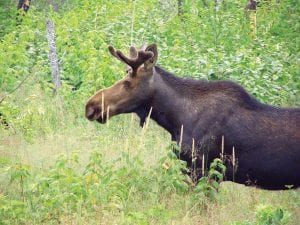A committee charged with making recommendations to slow the decline in Minnesota’s moose population presented its findings on August 18.
The committee, whose work will be incorporated into a legislatively mandated research and management plan, shared its insights with the Minnesota Department of Natural Resources (DNR) on research needs, habitat management and other considerations at a meeting in Duluth. The expert committee was formed, in part, because moose numbers have declined dramatically in northwestern Minnesota during the past two decades and may be declining in northeast Minnesota.
Rolf Peterson, chair of the DNR Moose Advisory Committee, said key committee findings include:
» While climate change
is a long-term threat to the moose in Minnesota, moose will likely persist
in Minnesota for the foreseeable
future.
» Moose hunting can continue
in northeastern Minnesota though key harvest and population data must be monitored as part of a strategy to
identify when a closure
would be appropriate.
» White-tailed deer
should be managed at low densities in northeast Minnesota’s moose range – essentially the Arrowhead portion of the state – to reduce the deer’s parasite-related impacts to moose. Recreational
feeding should be prohibited
in the moose range.
» Monitoring of the moose
population is critical. Additional research is needed to improve habitat, management, and
understanding of the species.
The committee also called for increasing the moose’s public profile through vigorous outreach and education.
Peterson, a professor at Michigan Technical University who studies wolf and moose in Isle Royale National Park in one of the world’s longest wildlife study, said committee members are concerned about high mortality among moose from health-related causes. Still, details are poorly understood.
“For example, the connections between parasites, disease and mortality exist but how they interrelate is not clear,” he said. “Managing white-tailed deer at a density of fewer than 10 per square mile would reduce the potential for parasite-mediated impacts on moose.”
Peterson said committee members recognize climate change as a clear long-term threat to the persistence of moose in Minnesota but the rate and extent of change during the next 50 years are unknown. Worst-case scenarios would create a serious threat but, for the foreseeable future, committee members expect moose to remain in Minnesota.
The committee did not believe evidence supported listing moose as a state-designated threatened or endangered species. A narrow majority of committee members who voted believe the moose should be identified as a “species of special concern,” a designation that would more accurately reflect the animal’s vulnerable status. This designation is advisory and conveys no additional legal status.
TheDNR created the committee in September 2008 in response to growing concern about the long-term future of this iconic species of the north. Committee members represent a cross-section of moose interests, including land managers, wildlife managers, tribal staff, conservation organizations and tourism.
Minnesota’s current moose population is about 7,600, almost all located within the heavily forested and wetlandrich northeast portion of the state. This contrasts to Minnesota’s northwest moose population, which declined from at least 4,000 animals in the early 1980s to fewer than 100 today.
“We commend the committee for its hard work, commitment and diligence,” said Dennis Simon, DNR wildlife section chief. “This is exactly the kind of information, consideration and discussion we need to develop a moose management and research plan that creates every opportunity for moose to persist in Minnesota.”
The DNR will review and consider the committee’s recommendations as it drafts a moose management and research plan, Simon said. Once completed, the draft plan will be released for public comment. Information about the committee and its complete report is available on the DNR Web site at www.mndnr. gov/moose



Loading Comments